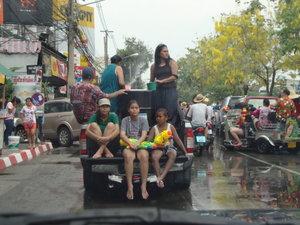Songkran festival in Chiang Mai
On 2012-08-19

Songkran today is still the most important of all the Thai festivals and holidays. It marks the beginning of a new astrological year and is much in keeping with the old lunar calendar of Siam. It is officially celebrated this year on April 12, but the festival actually takes place over a period of four days. It includes the 'Troot Festival' discussed above as well as all the merit-making at Buddhist temples and the ultimate Songkran, or The Pouring of Water ritual, by which we have come to identify Songkran with today. Each year, the four-day celebration of Songkran consists of many activities, and these are briefly explained below.
April 12 . This is a day for house cleaning and general preparation for the New Year. In the evening it is traditional for Thais to dress up as a signal of the coming new year.
April 13 . On this day people prepare cooked meals and preserved food for the Buddhist merit-making that takes place on the following day.
April 14 . On this day a grand new year begins with early morning merit-making at the temples. Preserved and cooked foods, fresh fruit, monks' robes and other offerings are made at the temples. In the home, people do the final cleaning of Buddha images using scented water.
April 15 . On this day homage is paid to ancestors, elders and other persons deserving respect because of age of position. This is called 'Rohd Nam Songkran', meaning 'The Pouring of Songkran Water', and the water is sprinkled on the elder persons while uttering wishes of good luck and a happy future.
Songkran procession : This is a parade through Chiangmai comprised of Buddha images and attendants on floats, which are accompanied by minstrels and the town's people. The procession begins at Nawarat Bridge on the Mae Ping River and moves the Thapae Gate before approaching its final destination of Wat Prasingh.

